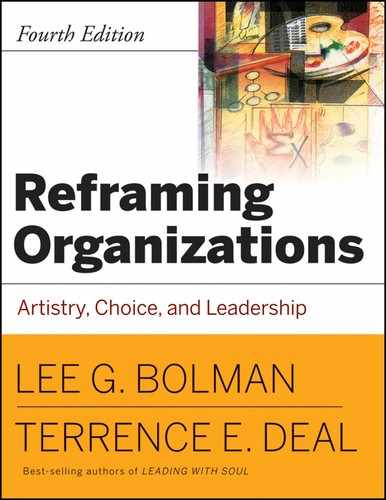What images or associations come to mind when you think about each of these terms?
It is likely that you had emotional, even visceral, reactions to many of these familiar words. Each refers to a specific person, group, place, or event, but each has also acquired symbolic resonance. Symbols carry powerful intellectual and emotional messages; they speak to both the mind and the heart.
The symbolic frame focuses on how humans make sense of the chaotic, ambiguous world in which they live. Meaning, belief, and faith are its central concerns. Meaning is not given to us; we have to create it. There are, for example, many who revere the American flag and many others who burn it. The flag is symbolically powerful for both groups, but for different reasons. It represents patriotism for one group, oppression or imperialism for the other. Symbols are the basic building blocks of the meaning systems, or cultures we inhabit. We experience our way of life in the same way that fish live in water. Our own cultural ways are often invisible to us because we see them simply as the ways things are—and ought to be. But we can react with revulsion and horror to cultures that are alien or hostile to our own. Consider the following words from an Al Quaeda instruction manual captured in Europe:
Committed to uniting all Muslims under a new caliphate, Al Qaeda believes that only force can achieve this mission: The confrontation that we are calling for ... does not know Socratic debates, Platonic ideals, nor Aristotelian dialogues. But it knows the dialogue of bullets, the ideals of assassination, bombing and destruction, and the diplomacy of the cannon and the machine gun. Islamic governments have never been and will never be established through peaceful solutions and cooperative councils. They are established as they have always been by pen and gun, by word and bullet, by tongue and teeth [Al Quaeda, n.d.].
The message is appalling to most Westerners, yet inspiring to those who share its particular vision of a restored caliphate. As symbols often do, the words carry an emotional wallop that may be very positive or very negative, depending on your perspective.
In Chapter Twelve, we explore the many forms symbols take in social life, including myth, vision, story, heroes and heroines, ritual, and ceremony. We then use a variety of examples to demonstrate what culture is and why it is so important.
In Chapter Thirteen, we apply symbolic concepts to team dynamics. We use a detailed account of a highly successful computer development team to show that the essence of its success was cultural and spiritual. The team relied on initiation rituals, humor, play, specialized language, ceremony, and other symbolic forms to weld a diverse and fractious group of individuals into a spirited, successful team.
Chapter Fourteen highlights dramaturgical and institutional perspectives, viewing organizations as akin to theater companies that seek recognition and support by staging dramas that both please and influence their audiences. We show that many activities and processes in organizations, such as evaluation and strategic planning, rarely achieve supposed goals. Yet they persist because they project vital messages that internal and external audiences want to hear.
